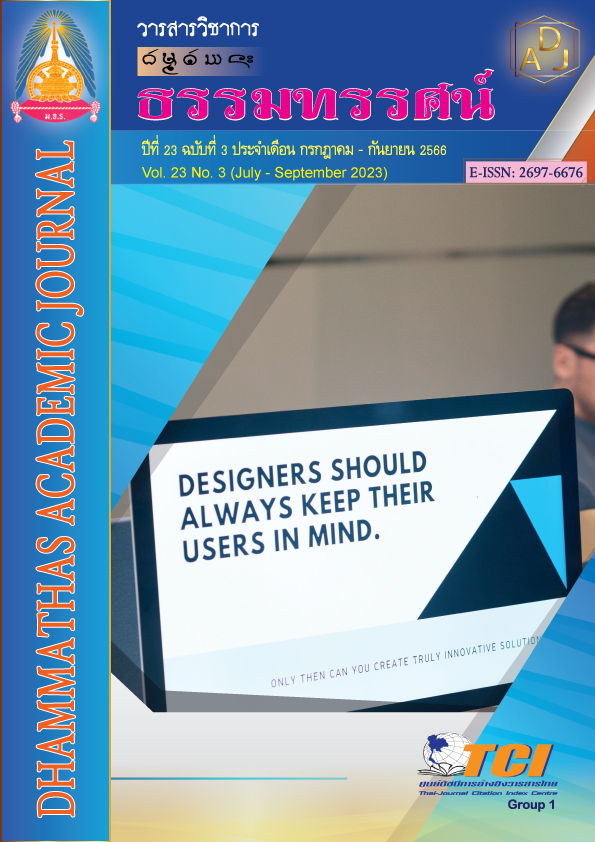Human Resource Management in the Buddhist way in the 21st Century
Main Article Content
Abstract
This academic article aims to present the Buddhist way of human resource management in the 21st century, to get the organization to face a dynamic and constantly adapting environment. Also, this Buddhist way helps the organization to develop and survive. Thus, the researcher has brought the four Sangahavatthu principles, to adapt as a basis for practicing. The contextual change of the periods and the influence from the stimuli of the causal factor may bring the organization to difficulties. For this reason, the objective of this article is to apply the Buddhist way in human resource management effectively and always is ready to cope with the change in managing people to match the current era using the four Sangahavatthu principles, to enable personnel and organization to work efficiently.
Article Details

This work is licensed under a Creative Commons Attribution-NonCommercial-NoDerivatives 4.0 International License.
เพื่อให้เป็นไปตามกฎหมายลิขสิทธิ์ ผู้นิพนธ์ทุกท่านต้องลงลายมือชื่อในแบบฟอร์มใบมอบลิขสิทธิ์บทความ ให้แก่วารสารฯ พร้อมกับบทความต้นฉบับที่ได้แก้ไขครั้งสุดท้าย นอกจากนี้ ผู้นิพนธ์ทุกท่านต้องยืนยันว่าบทความ ต้นฉบับที่ส่งมาตีพิมพ์นั้น ได้ส่งมาตีพิมพ์เฉพาะในวารสาร วิชาการธรรม ทรรศน์ เพียงแห่งเดียวเท่านั้น หากมีการใช้ ภาพหรือตารางของผู้นิพนธ์อื่นที่ปรากฏในสิ่งตีพิมพ์อื่นมาแล้ว ผู้นิพนธ์ต้องขออนุญาตเจ้าของลิขสิทธิ์ก่อน พร้อมทั้ง แสดงหนังสือที่ได้รับการยินยอมต่อบรรณาธิการ ก่อนที่บทความจะได้รับการตีพิมพ์References
กิตติ มิลำเอียง. (2559). การสรรหาและคัดเลือกทรัพยากรมนุษย์ในองค์การภาครัฐยุคใหม่. วารสารมนุษยศาสตร์และสังคมศาสตร์ มหาวิทยาลัยราชภัฏสุราษฎร์ธานี, 8(1), 131-152.
เดชา เดชะวัฒนไพศาล. (2559). การจัดการทรัพยากรบุคคล พื้นฐานแนวคิดเพื่อการปฏิบัติ. กรุงเทพฯ: จุฬาลงกรณ์มหาวิทยาลัย.
ธรรมรักษา. (2532). พระไตรปิฎก ฉบับสุภาษิต. กรุงเทพฯ: รุ่งแสง.
ธัญญา ผลอนันต์. (2549). การมุ่งเน้นทรัพยากรบุคคล: แนวทางสร้างความพึงพอใจแก่พนักงาน. (พิมพ์ครั้งที่ 4). กรุงเทพฯ: อินโนกราฟฟิกส์.
ธำรงศักดิ์ คงคาสวัสดิ์. (2550). ทุนมนุษย์การกำหนดตัวชี้วัดเพื่อการพัฒนา. กรุงเทพฯ: สมาคมส่งเสริมเทคโนโลยี (ไทย-ญี่ปุ่น).
บุญทัน ดอกไธสง. (2551). การจัดการทุนมนุษย์. กรุงเทพฯ: พิมพ์ตะวัน.
พระมหาจีรวัฒน์ กนฺตวณฺโณ. (2559). การพัฒนาทรัพยากรมนุษย์: แนวคิดและบทบาท องค์กรทางศาสนาพุทธและศาสนาคริสต์. วารสารเซนต์จอห์น, 21(29), 307-320.
พิชิต เทพวรรณ์. (2554). การจัดการทรัพยากรมนุษย์เชิงกลยุทธ์. กรุงเทพฯ: ซีเอ็ดยูเคชั่น.
วิลาวรรณ รพีพิศาล. (2554). การบริหารทรัพยากรมนุษย์. (พิมพ์ครั้งที่ 3). กรุงเทพฯ: วิจิตรหัตถกร.
สัมฤทธิ์ ยศสมศักดิ์. (2549). การบริหารทรัพยากรมนุษย์. กรุงเทพฯ: เอ็ม. ที. เพรส.
เอนก สุวรรณบัณฑิต และภาสกร อดุลพัฒนกิจ. (2548). จิตวิทยาบริการ. กรุงเทพฯ: เพรส แอนด์ดีไซน์.
Clark, R. (1992). Human Resources Management: Framework and Practice. (2nd ed.). Jim Kitay: University of Sydney.
Nadler, L. & Wiggs, G. D. (1989). Managing human resources development. SanFrancisco, California: Jossey-Bass.

